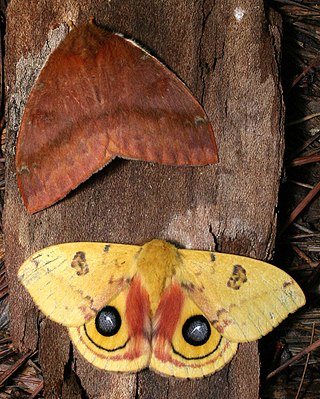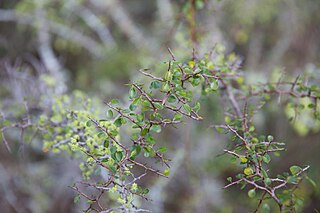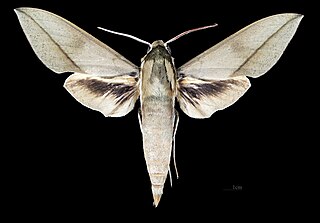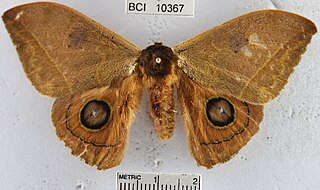
The orange-crowned warbler is a small songbird of the New World warbler family.

Automeris io, the Io moth or peacock moth, is a colorful North American moth in the family Saturniidae. The Io moth is also a member of the subfamily Hemileucinae. The name Io comes from Greek mythology in which Io was a mortal lover of Zeus. The Io moth ranges from the southeast corner of Manitoba and in the southern extremes of Ontario, Quebec, New Brunswick and Nova Scotia in Canada, and in the US it is found from Montana, North Dakota, South Dakota, Nebraska, Colorado, New Mexico, Texas, Utah, east of those states and down to the southern end of Florida. The species was first described by Johan Christian Fabricius in 1775.

Ziziphus celata, commonly known as the Florida jujube or Florida ziziphus, is a terrestrial flowering plant endemic to central Florida.
Sarcohyla celata, also known as the Oaxaca treefrog, is a species of frog in the family Hylidae. It is endemic to Mexico and only known from the Sierra de Juárez in northern Oaxaca. After having not been seen after 1984, it was feared that the species might be extinct. However, the species was rediscovered in field surveys during 2011–2014 and some subpopulations are at healthy levels.

Grevillea celata, commonly known as Nowa Nowa grevillea or Colquhoun grevillea, is a species of flowering plant in the family Proteaceae and is endemic to a restricted part of Victoria in Australia. It is an erect and open to low, dense shrub with oblong, broadly elliptic or linear leaves, and red and yellow, or red, white and apricot-coloured, sometimes all yellow flowers.

Automeris larra is a moth of the family Saturniidae. It is found in South America, including Brazil, French Guiana, Venezuela, Colombia, Peru, Bolivia and Ecuador.

Theretra celata is a moth of the family Sphingidae. It is known from the Moluccas east to Vanuatu and south to Australia. It is often treated as a subspecies of Theretra clotho.

Automeris is a genus of moths in the family Saturniidae and the subfamily Hemileucinae. As of 1996 there were 124 species, and more have since been described. These moths are generally characterized by the eyelike patches on the hindwings and the leaflike pattern on the forewings, an example of crypsis. The genus was first described by Jacob Hübner in 1819 and it is distributed in the Neotropical realm.

Automeris duchartrei is a moth of the family Saturniidae first described by Eugène Louis Bouvier in 1936. It is found in Ecuador, Bolivia and Peru.

Automeris zugana is a moth of the family Saturniidae first described by Herbert Druce in 1886. It is found from Panama to western Ecuador. The habitat consists of hyperhumid tropical rain forests at altitudes between 60 and 1,400 meters.

Automeris belti is a moth of the family Saturniidae first described by Herbert Druce in 1886. A. belti is found from Mexico to Colombia and Ecuador. The wingspan is 95–100 mm.

Automeris postalbida is a moth of the family Saturniidae first described by William Schaus in 1900. It is found from Costa Rica to Ecuador.
Automeris randa, Rand's eyed silk moth, is a species of buck and io moths in the family Saturniidae. It was described by Herbert Druce in 1894 and is found in Central and North America.
Automeris louisiana, the Louisiana eyed silkmoth, is a species of moth in the family Saturniidae. It is found in North America.
Automeris zephyria, the zephyr eyed silkmoth, is a species of insect in the family Saturniidae. It is found in North America.
Automeris cecrops, the cecrops eyed silkmoth, is a species of insect in the family Saturniidae. It is found in Central America and North America.
Automeris patagoniensis, the Patagonia eyed silkmoth, is a species of insect in the family Saturniidae. It is found in North America.
Automeris iris, the iris eyed silkmoth, is a species of insect in the family Saturniidae. It is found in Central America and North America.

Automeris curvilinea is a species from the genus Automeris. The species was originally described in 1906 by William Schaus.

Automeris amanda, commonly known as the peacock silkmoth or peacock moth, is a species of moth in the family Saturniidae. It is indigenous to South America.











